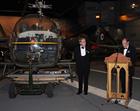Royal Marines squadron marks 50 years of commando support
The ‘flying eyes’ of the Royal Marines past and present gathered in Yeovilton to celebrate 50 years of keeping the commandos at least one step ahead of their foes on the battlefield.
3 Commando Brigade Air Squadron – which today has morphed into 847 Naval Air Squadron – started life as an aerial reconnaissance unit, but over its varied lifespan (five helicopter types in five decades) has conducted battlefield scouting, overwatch for convoys, tank busting outside Basra, fire support direction and casualty evacuation.
3 BAS – as it was abbreviated – started life in Singapore with the tiny Sioux helicopter in 1968, before relocating to Coypool in Plymouth as part of the withdrawal from East of Suez in 1971 with a mix of Sioux and more powerful Scouts as it became an anti-tank/general duties/reconnaissance squadron.
As the 1970s progressed the squadron received the legendary Gazelle – and took the bulbous helicopters, plus Scouts, to the Falklands in 1982 where the 15 helicopters clocked up over 2,000 hours in support of the islands’ liberation.
Air and ground crew faced grim conditions and frequent air attack, especially during the first few days after the San Carlos landings, and three helicopters were brought down by enemy fire; four aircrew were killed and two wounded.
After the Falklands, the squadron moved to Yeovilton and received Lynx armed with TOW anti-tank missiles – the two would be a mainstay of operations for the next 25 years.
3 BAS became 847 NAS in 1995 – and in that guise enjoyed arguably its finest hour during the 2003 invasion of Iraq when Lynx destroyed more than 40 enemy targets – including heavy armour – around Basra during the battle for Iraq’s second city.
The Gazelle was retired in 2005 and the Lynx followed it in 2013 when 847 became the first squadron in the UK’s armed forces to receive the new battlefield Wildcat.
Around 80 personnel from the squadron’s past and present toasted the centennial milestone at a formal evening in the Fleet Air Arm Museum, where some retired helicopters were on display – providing a talking point for older members of the 3 BAS/847 community to share the odd ‘dit’ with the younger generation of pilots.
Among the doyens of the squadron attending were Tim Donkin – the first Commanding Officer, Major Dave West RM (currently in charge of Clockwork, the annual training exercise in Norway) – the oldest 3 BAS RM pilot ever to have served and Major Peter ‘Nobby’ Clarke, 847’s Executive Officer – last of the 3 BAS RM pilots still serving with the squadron.
Guest speaker was former 847 NAS senior pilot, now Director Carrier Strike, Rear Admiral Matt Briers, who updated his audience on the future of Commando Helicopter Force, to which the squadron belongs, as well as the wider Royal Navy.








